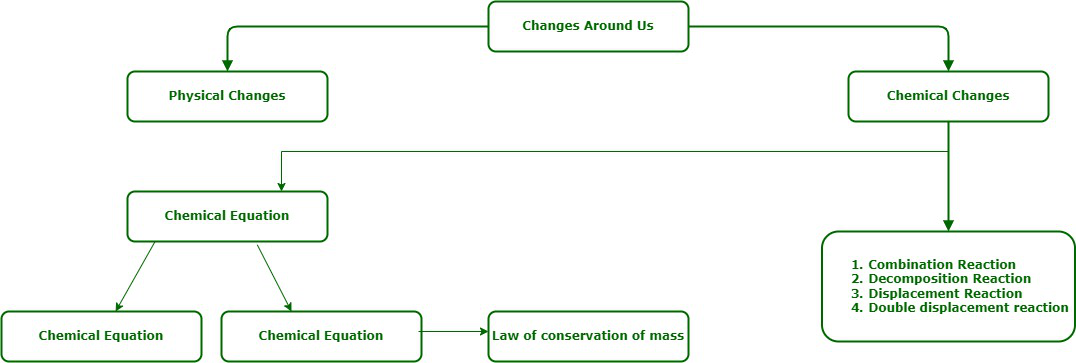|
|
In reactants
|
In products
|
|
Number of C atoms
|
1
|
1
|
|
Number of H atoms
|
4
|
4
|
|
Number of O atoms
|
4
|
4
|
In this chemical equation, there are equal number of different types of atoms in the reactants and products, so it is a balanced equation.
Detailed description for better understanding of above example-
The above equation can be made more informative by indicating the physical states of the reactants and products as well as the heat changes that take place in the reaction as discussed below:
- Methane is a gas- CH4(g)
- Oxygen is a gas- O₂(g)
- Carbon dioxide is a gas- CO₂ (g)
What about the physical state of H₂O?
If the reaction takes place in an aqueous medium, then H₂O is in the liquid state and we write H-O(1) for it. If the reaction takes place in the vapor phase, then H₂O is in the gaseous state and is denoted as H₂O (g). In this case, methane gas burns into oxygen gas to form carbon dioxide gas and water vapor or stream. So the water here is in the gaseous state and is H₂O (g). If we put the physical states of all the reactants and products, then the equation can be written as-
CH4(g) + 2O2(g) → CO2(g) +2H2O(g)
Now, the heat that takes place in this reaction changes. When methane burns in oxygen to form carbon dioxide and water, a lot of heat is also produced, so it is an exothermic reaction. An exothermic reaction is indicated by writing a “+heat” sign on the product side. So, the above equation can finally be written as:
CH4(g) + 2O2(g) → CO2(g) +2H2O(g) + Heat
This equation now gives the physical states of those reactants and products as well as the heat changes that take place in the reaction, so it is a more informative equation.
Sample Questions
Question 1: List any four changes around you through which we can determine whether a chemical reaction has taken place or not.
Answer:
- Respiration of animals,
- Digestion of food,
- Burning of coal, and
- Rusting of iron.
Question 2: Mention any three observations which help in determining whether a chemical reaction has taken place or not. Write an activity that can justify at least two of the comments listed.
Answer:
Observations:
- Change in state,
- Change in color,
- Evolution of a gas,
- Change in temperature.
Activity:
- Some zinc granules are taken in a conical flask.
- A small amount of dilute hydrochloric acid is poured over it.
- It is observed that the zinc granules start decreasing in size and hydrogen gas is released.
- The temperature of the flask also rises slightly.
Question 3: Mention three ways by which a general chemical equation can be made more informative.
Answer:
There are three ways to make a general chemical equation more informative:
- By balancing the chemical reaction, the number of atoms of each reactant and product can be made equal.
- More information about the physical states of reactants and products can be obtained by referring to their physical states (s, l, g, aq).
- The heat must be specified in favor of the reactants or products in order to identify an endothermic or exothermic reaction.
Question 4: Seema bought the packet of chips and opened it. Suddenly his friend Shanu came. She started playing and forgot to eat chips. The next day when he ate the chips, he felt that the taste was not good and he was not feeling well. He asked his mother to take him to the doctor. The doctor told him that this happened due to eating stale chips. He gave medicines due to which Seema got well within a few days.
(a) Why do chips stay fresh longer in sealed packets?
(b) Why did the open packet chips go bad?
(c) What value do you learn from this passage?
Answer:
(a) This is because sealed packets of chips are usually filled with a gas such as nitrogen, which prevents the chips from oxidizing.
(b) The fats and oils present in the open packet of chips get oxidized. They become rancid and their smell and taste change.
(c) Food items should be stored in airtight containers or in the refrigerator to prevent oxidation of the fats and oils present in them. Once the chips packets/food item gets spoiled, their smell and taste change. They should not be eaten because they are not good for our health.
Question 5: What is the physical state of H₂O in a chemical reaction?
Answer:
If the reaction takes place in an aqueous medium, then H₂O is in the liquid state and we write H-O(1) for it. If the reaction takes place in the vapor phase, then H₂O is in the gaseous state and is denoted as H₂O (g).
